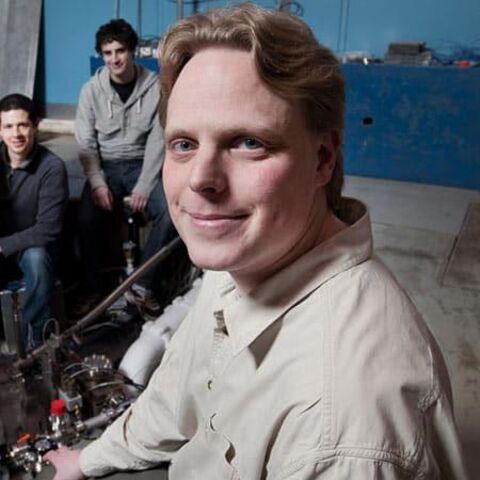Matthias Liepe
Professor
Radio Frequency Superconductivity, Superconducting Quantum Materials, and Accelerator Physics
My research focuses on studying the science and technology of bulk and thin-film superconductors in electromagnetic fields at low temperature and ultra-high frequencies and the application of these superconductors, e.g., in superconducting RF cavities for particle accelerators and quantum computing.
Research
Superconducting radio frequency (RF) cavities are feet-long structures, providing extremely high electric field gradients (tens of MV/m) for the acceleration of charged particle beams. The electric field inside these cavities oscillates at GHz frequencies, with exceptional high quality factors of 1E10 to 1E11. By using superconducting materials operated at temperatures between 1.5K and 4K for the walls of the cavities, we can achieve such high efficiency. The evolution in the performance of superconducting cavities has revolutionized the performance and scientific reach of particle accelerators for a variety of science applications, including high-energy physics, nuclear physics, synchrotron radiation-based research, and high-power lasers. Future particle accelerators for science, industry, energy generation, and medical applications all rely on the performance we hope to achieve in next-generation superconducting RF cavities.
I am the head of Cornell’s Superconducting Radio Frequency (SRF) group, which is a world leader in the science of microwave superconductivity and its application to accelerating cavities for particle accelerators. We have an extensive, state of the art infrastructure for the design, fabrication, preparation and test of superconducting cavities. Our research program is multi-faceted with high-impact and visibility. We have established a wide range of collaborations with international and national accelerator labs as well as with industry. We are part of the NSF Center for Bright Beams (CBB), which gives our graduate students exciting opportunities for interdisciplinary collaborative research.
SRF cavities not only enable accelerator-based sciences, but they also allow measuring superconducting response under extreme conditions with very high sensitivity. They allow the study of surface resistance, critical fields, superconducting magnetic microwave shielding, and the metastability of the superheating-field barrier. They are a testing ground for the science of disorder and defects, coupling superconductivity and high fields to grain boundaries, surface anisotropy, surface oxides, and crystal orientation. My current research concentrates on the following areas:
Synthesis, characterization, and microwave surface resistance of new superconducting compound materials for SRF cavity applications
Current SRF cavities exclusively use niobium as superconductor and are approaching theoretical limits. However, new potentially game-changing materials (e.g. Nb3Sn, MgB2, NbN) have the potential for fields and cavity quality factors far above the niobium limit. Moving to higher-kappa, compound superconductors brings new questions: What alternative superconductors with critical temperatures higher than that of niobium can open the path towards a new generation of SRF cavities with even lower RF surface resistance and higher accelerating fields? Does the small coherence length of these superconductors limit their usefulness due to grain boundary losses or defects? How can these more complex compound superconductors be synthesized with ideal stoichiometry and defect free? Our research program on Nb3Sn is world leading and has resulted in the first ever alternative material SRF cavity to clearly outperform traditional niobium cavities.
Superheating fields in superconductors
The highest gradient niobium SRF cavities are operated with peak magnetic fields beyond Hc1, the field where vortices (that would cause massive losses) would penetrate in equilibrium. Operation is possible until a higher superheating field Hsh because of a surface barrier to flux penetration. Our group has done a first measurement of the full temperature dependence of the superheating field of niobium using SRF cavities and has shown that it depends strongly on the preparation of the niobium surface. Much remains unknown. How does the superheating field depend on the Fermi surface anisotropy, i.e. could optimally oriented superconducting surfaces offer higher fields in SRF cavities? How do strong-coupling effects, as present in many of the higher-temperature traditional superconductors, impact Hsh? Can defects bypass the metastable superheating-field barrier for large-kappa materials?
Processing, characterization and microwave surface resistance of the RF surface penetration layer of superconductors
The surface resistance of a superconductor in microwave fields is determined by a highly complex surface layer of a few 100 nm thickness (roughly the penetration depth of the field), with oxides, grain boundaries, impurities, and defects present. This surface resistance, and is observed strong field dependence, strikingly depend on the surface treatment protocol. For example, we have shown the doping of niobium with impurities can drastically reduce RF surface resistance by optimizing the electron mean free path and reducing overheating of the quasiparticles. Open questions include: What is the physics underlying the residual surface resistance at the lowest temperatures? What are the effects of surface oxides on the surface electronic structure of materials and their impact on RF cavity performance characteristics? What surface morphology and (likely) mixed metallic phases arise from electrochemical polishing of niobium? What are the sources of the observed strong field dependence of the microwave surface resistance, and how does it depend on impurity doping?
Developing the superconducting linac technology for future high-power, high energy-efficiency particle accelerators
In addition to designing and optimizing the cavities for future superconducting accelerators, we are developing related and technologically challenging components like RF input couplers, Higher-Order-Mode dampers and frequency tuners. We are designing, building and testing entire, complex SRF cryomodules. This work relates to a wide breath of scientific and engineering questions. A particular focus of our work is on making future particle accelerators much more energy efficient.
Educational Background
Diplom, 1998, University of Hamburg, Germany. Visiting Scientist, Cornell University, 1998-1999. Ph.D., 2001, University of Hamburg, Germany. Research Assistant, Deutsches Elektronen Synchrotron, DESY, Germany, 1998-2001. Research Associate, Cornell University 2001-2006. Assistant Professor, Cornell University, 2006-2013. Alfred P. Sloan Research Fellow, 2008-2012. Associate Professor, Cornell University, 2013-2018. Professor, Cornell University, 2018-present. Graduate and Professional Student Assembly (GPSA) Faculty Award, 2015. Cornell Superconducting RF Group Leader, 2016-present.

